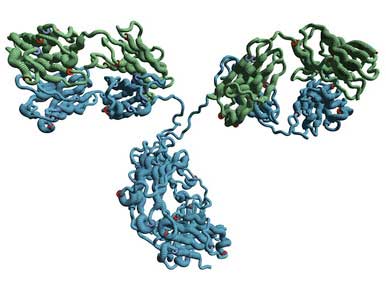| Nov 30, 2017 |
Computer analysis fills gaps in antibody blueprint
|
|
(Nanowerk News) Antibodies defend our bodies against intruders. These molecules consist of proteins with attached sugars. However, the blueprint directing the processing of these sugars on the protein was not well understood until now. In a paper published in the journal Nature Communications ("Network inference from glycoproteomics data reveals new reactions in the IgG glycosylation pathway"), scientists from the Helmholtz Zentrum München used computer analysis to complete this blueprint and confirmed their findings in the laboratory.
|
 |
| Structure of an antibody.
|
|
The authors specifically studied IgG antibodies.* These are the most common antibodies in blood and act especially against viruses and bacteria. "They have a characteristic Y shape and are composed mainly of protein", explains Elisa Benedetti, PhD student at the Institute of Computational Biology (ICB) of the Helmholtz Zentrum München. "However, during their production, the cell attaches different sugars to these protein molecules, and how this happens was until now not well understood", continues the first author of the study.
|
|
Understanding this process is of great interest to researchers, because the identity of the sugar that is attached (in a process called glycosylation) dramatically influences the function of the antibody. While one sugar molecule might promote inflammation upon contact with an antigen, another might suppress the immune response.
|
Using computers to solve a biochemical problem
|
|
"The difficulty in studying the glycosylation blueprint lies, among other things, in the complex regulation of how the corresponding enzymes work", explains last author Dr. Jan Krumsiek, junior group leader at the ICB and Junior Fellow at the Technical University of Munich. The bioinformaticians' strategy to solve this biochemically difficult problem was to tackle it in the digital realm.
|
|
To this end, the scientists analyzed data from the Croatian '10001 Dalmatians Biobank'. They first studied blood samples from almost 700 test subjects aged between 18 und 88 with respect to the sugars attached to their IgG antibodies. By investigating the correlation of the measured glycans to each other, authors found that they largely corresponded to previous known steps in the enzymatic process of IgG glycosylation. Indeed, on the basis of the data, the algorithm could reconstitute the already known blueprint - and develop it further.
|
|
"We could predict new steps of how the sugar residues must be attached to the antibodies", explains Krumsiek. "Using three additional cohorts comprising over 2,500 samples, we were able to replicate the statistical data." Subsequently, the researchers could substantiate the predicted steps using further methods: firstly, on the basis of a genome-wide association study with about 1,900 samples from the Augsburg-based KORA research platform**, and, additionally, in a series of three experiments in the laboratory.
|
|
"We could show in vitro that at least one of our predicted reactions is enzymatically feasible and we demonstrated in cell culture that particular enzymes that are predicted to work together in the model, do actually co-localize in the cell, that is, they are spatially very close to each other", says Krumsiek. "Our study shows how information technology and classical bench chemistry can support and enhance each other."
|

